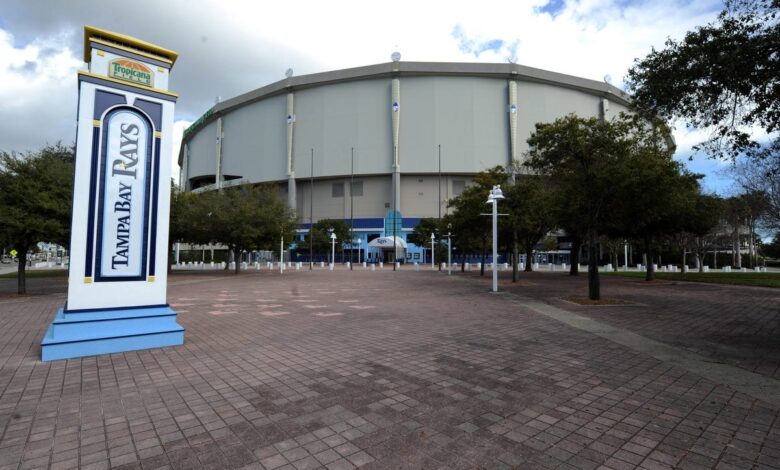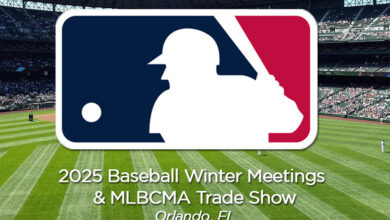
ST. PETERSBURG, Fla. – When Toronto Blue Jays’ second baseman Addison Barger grounded into a force to end a game on September 22 at Tropicana Field, the final out could be edged in history.
That grounder to Taylor Walls, who flipped to Jose Caballero, forced Vladimir Guerreo, Jr. at the bag. This ended in a Rays’ 4-3 victory before 20,567 and maybe the termination of baseball at Tropicana Field.
Destruction from hurricane Milton, which struck on October 9, ripped a significant portion off the roof of the 34-year-old structure and set the Rays spinning into darkness. Overall, the hurricane caused an estimated $34 billion of damage and, in the end, could be regarded as one of the costliest storms in United States history.
The devastation was widespread and impacted not only the Tampa Bay area, where the storm made landfall, but across the state. After two weekends following passage of the storm, beaches as far away as Cape Canaveral National Seashore on the east coast remained closed indefinitely and totality of the clean-up is expected to last months.
Of the communities and venues directly affected by two hurricanes, Helene and Milton within a two-week period, the most celebrated venue was Tropicana Field. Structural damage to the roof was nearly complete and the Rays cannot use Tropicana Field without a roof. That’s because the facility was built without a drainage system and the Tampa Bay region is susceptible to frequent and heavy rain events.
Nearly two weeks after the storm, there is little information on the physical structure, a time window to repair and overall assessment. Currently, the only information was a statement put out by the Rays just after the hurricane.
“Over the coming days and weeks,” the Rays said in that statement on Oct. 10, “we expect to be able to assess the true condition of Tropicana Field. In the meantime, we are working with law enforcement to secure the building.”
From a visual perspective, the damage was quite visible. Nearly all the 6 acres of translucent Teflon-coated Fiberglass suffered serious damage. Arial views from news helicopters showed little left to the roof. With 180 miles of cables connected by struts, reconstruction is expected to be timely and costly. The roof was constructed to withstand winds of 115 miles per hour, but the winds of Milton exceeded.
Therein lay the dilemma.
Do the Rays, who merely rent the structure from the city of St. Petersburg, fix the roof or simply demolish the building? In January, the Rays are expected to break down on a new $1.3 billon stadium and money has been allocated to begin the project. Completion is geared to the start of the 2028 season, and that gives three years for the Rays to determine a future home.
This is not the first time a tenant was forced out.
On Dec. 12, 2010, the inflatable roof of the Metrodome in Minneapolis collapsed under 17 inches of snow and ice. That forced the Minnesota Vikings and New York Giants to play at Ford Field in Detroit and $22.7 million was allocated to fix the fiberglass roof. After repairs, the Vikings continued to play in that venue until 2013 and that’s when the facility closed.
For the following two years, the team played outdoors at the University of Minnesota and then moved into their current home, U. S. Bank Stadium in 2016.
Another team forced to evacuate their venue was the Philadelphia Flyers and that was during their initial 1967-68 NHL season, On March 1, a large section of the Spectrum roof was blown off during a performance of the Ice Capades. That forced the closure of the building for the next month and the Flyers then played home games at their AHL Quebec City affiliate. The Flyers were able to return in early April and commence the opening round of the Stanley Cup playoffs against the St. Louis Blues.
The Rays may not be as fortunate. With extensive damage to the roof and interior sections of Tropicana Field, the team, and the city of St. Petersburg, must weigh the cost of repair and the time frame.
A report in the Tampa Bay Times suggested insurance costs may be a significant factor. Copley Gerdes, a St. Petersburg city council member, told The Times the city will pay for the first $45 million to $50 million for city assets, such as the St. Petersburg pier, sea walls, and the Trop falls into that category. To completely repair Tropicana Field, the cost will likely run in the millions, and an area where St. Petersburg would not go.
All of which begs the Rays to glance into a crystal ball.
The popular theme is the Rays will not open the 2025 season against the Colorado Rockies at Tropicana Field. In fact, the opening six-game home stand against the Rockies and Pittsburgh Pirates likely face relocation. The question simply is, where?
At this point, the Rays have a few options.
One could be their spring training site at Port Charlotte, about one hour south of the Tampa Bay region. Though familiar with fans, the facility could be outfitted to major league standards and the players association would have to sign off on such alterations.
Ditto for the Blue Jays’ spring home at Dunedin.
Because of the pandemic, Toronto played several “home games” in this facility and, like the Port Charlotte location, renovations would have to be made. For use as a training facility, the venue clearly resonates with players. “Easily the best spring training facility in the game,” said Jays’ pitcher Chris Bassett at the end of the 2024 season.
The most practical option would be ESPN Disney World of Sports in Orlando. It’s no secret the Rays would like to tap into the Orlando market, and this would be an ideal way to accomplish that goal. The Rays played six regular season games there in 2007 and 2008, but the venue is attractive to youth teams. Such a logistical issue would have to be resolved.
While it’s certain the Rays will gather at Port Charlotte in mid-February for spring training, any site for the 2025 championship season remains, at this point, very much uncertain.





